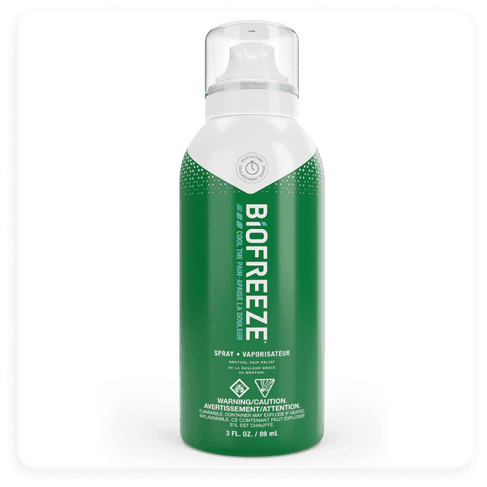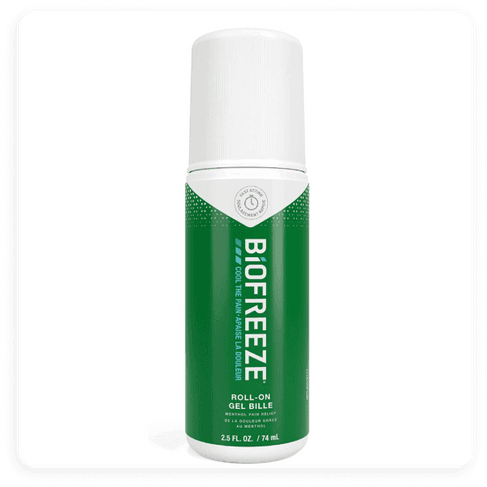Mess-free application
Hard to reach areas
Vanishing menthol scent

This article has been medically reviewed for accuracy
Ankle pain refers to any pain in the ankle joint area, which comprises three main bones. These are the shin bone (or tibia), the fibula, and the talus1. Pain in your ankle could be because of injuries to any one of these bones, or the components between them. Certain health conditions like osteoarthritis may also cause flare-up symptoms leading to ankle pain2.
In this guide, we cover common ankle pain causes, frequent symptoms experienced with ankle pain, and various treatment options available.
The most common ankle pain causes fall under three categories: 1) injury, 2) arthritis, and 3) wear and tear3.
If you're feeling pain it may be due to:
Learn more about arthritis joint pain in our guide here.
Learn more about the common causes of joint and muscle pain here.
Ankles are important joints that facilitate walking movement1 and balance, so naturally, ankle pain can be a real drag.
Other ankle pain symptoms1 that can impact quality of life
Most mild cases of ankle pain can be treated with over-the-counter options, rehabilitation, and at-home remedies5.
However, if your ankle pain is severe, especially following an injury that causes you to be unable to bear weight5, consult your healthcare provider to see whether you require a different form of ankle pain treatment.
Over-the-counter options for ankle pain include oral pain relievers and topical analgesics that provide soothing pain relief.
Oral pain relievers that may provide short-term pain relief for aching ankles6 include but are not limited to acetaminophen or a Non-Steroidal Anti-Inflammatories like Ibuprofen. Before use, check with your healthcare provider to see if over-the-counter options are suitable for the type of pain that you have.
Topical analgesics like Biofreeze topical products* provide pain relief via external application. Biofreeze* products are menthol-based, providing cooling sensations and pain relief for joint pain7. For a unique area like the ankle, Biofreeze Spray* and Biofreeze Roll-On* are perfect for targeted pain relief.
Those who are recently injured may have been prescribed the RICE method. RICE stands for rest, ice, compression, and elevation8. One of the main components of RICE is of course the ice, or cold therapy.
Ice can decrease inflammation9 at the site of injury and help reduce or control pain. Ice application has been proven to decelerate nerve activity10. This means it may slow the rate at which your pain signals fire, leading to a decrease in pain perception, and an increase in pain tolerance.
Cold therapy should be avoided10 if you have:
Find out more about cold therapy in our guide, here.
Learn more about whether you should use heat or ice on muscle pain in our guide, here.
Heat therapy can also be useful in providing pain relief10. Heat therapy helps dilate blood vessels and increase blood flow11, encouraging relaxation and recovery in stiff and sore muscles.
However, heat therapy should not be used if there is visible bruising, swelling, and/or inflammation10. Heat therapy should also be avoided if you have impaired sensory perception (not being able to tell if the heat application is too hot) and/or an open wound.
If you suffer from exercise-induced12 pain, alternating between cold therapy and heat therapy may be an effective ankle pain treatment for pain relief, compared to just resting.
Physical therapy is a common pain treatment, particularly following an injury13. It can help restore strength, range of motion, and stability. If you've recently sprained or injured your ankle, you can expect to practice different ankle stretches and ankle strengthening exercises that promote recovery from injury and prevent future ones.
It is also not uncommon to have multiple physical therapy sessions per week when undergoing a physical therapy program14. While it may require more time and commitment upfront, physical therapy may be useful for longer-term preventative care.
In addition to the ankle pain treatments above, certain lifestyle changes can help to reduce the daily impact and stress on your ankles, minimizing the occurrence of pain.
Try the following:
While many cases of ankle pain may improve on their own with at-home pain treatments, there are instances where you should consult your healthcare provider about your ankle pain.
These include:
Even if you are not completely sure whether your ankle pain is serious, a healthcare provider can help you determine the cause of your pain, so you can treat it appropriately.
*Ensure this product is right for you. Always read and follow the product label.
Mess-free application
Hard to reach areas
Vanishing menthol scent
No mess & portable
Targeted relief
Easily covers small & large areas
This article has been medically reviewed for accuracy



Mess-free application
Hard to reach areas
Vanishing menthol scent
No mess & portable
Targeted relief
Easily covers small & large areas
